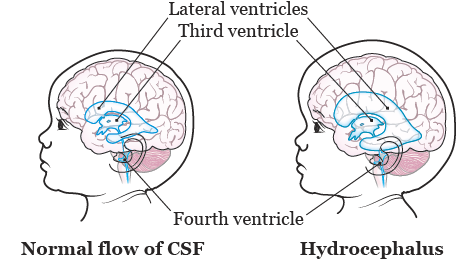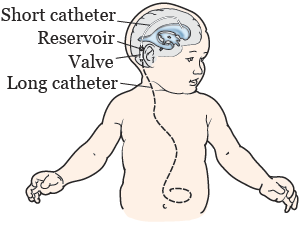This information will help you learn about your nonprogrammable ventriculoperitoneal (ven-TRIK-yoo-loh-PAYR-ih-toh-NEE-ul), or VP shunt. In this resource, the words “you” and “your” mean you or your child.
A VP shunt is a device used to drain extra cerebrospinal fluid (CSF) from your brain. CSF is a liquid that is made in the ventricles (hollow spaces) in your brain.
CSF protects your brain and spinal cord by acting like a cushion. It also brings nutrients throughout your brain and carries waste away. You’re making new CSF all the time.
CSF flows from your ventricles, around your brain and spinal cord, and into your bloodstream. If extra CSF builds up in your ventricles, it can cause hydrocephalus (HY-droh-SEH-fuh-lus).
Hydrocephalus is when extra CSF makes your ventricles bigger and puts pressure on your brain (see Figure 1). Hydrocephalus can happen if the flow of CSF is blocked. It also happens if not enough CSF is absorbed into your bloodstream.

About your VP shunt
A VP shunt is a device placed in your body during a surgery. The shunt drains the CSF out of your brain and moves it into your abdomen (belly). Then it’s absorbed by your body. This lowers the pressure and swelling in your brain.
A VP shunt has 3 parts (see Figure 2):

- A one-way valve and reservoir that controls the flow of CSF.
- A short catheter (thin, flexible tube) that drains the CSF from your brain. It’s attached to the valve. It can be placed in the front, back, or side of your head.
- A long catheter that moves the CSF into your abdomen. It’s attached to the valve. It’s placed under your skin, behind your ear, down your neck, and into your abdomen.
To learn more, read About Your Ventriculoperitoneal (VP) Shunt Surgery at MSK Kids.
As the VP shunt drains extra CSF and lowers the pressure in your brain, it may relieve your symptoms. Some symptoms will go away right after your surgery. Others will go away more slowly, sometimes over a few weeks.
About your nonprogrammable VP shunt settings
The amount of CSF your VP shunt drains depends on its pressure setting. With a nonprogrammable VP shunt, your neurosurgeon will choose the pressure setting before they place the shunt. The setting cannot be changed after the nonprogrammable VP shunt is in place.
Your nurse will give you a wallet card that says you have hydrocephalus and a nonprogrammable VP shunt. You can also print it from Hydrocephalus With Shunt (Wallet Card). Carry the card with you at all times. If you need emergency medical care, show it to the medical workers.
Safety guidelines to follow while you have a nonprogrammable VP shunt
Wear MedicAlert® jewlery
You should always wear a MedicAlert bracelet or necklace that says you have hydrocephalus and a nonprogrammable VP shunt. This will help emergency service workers care for you if you’re ever badly ill or hurt and need medical help.
You can buy a MedicAlert bracelet or necklace at most drug stores. You can also ask a member of your care team for an application. Visit the MedicAlert website at www.medicalert.org to learn more.
Continue with imaging scans
You can have any imaging scan done after your surgery. This includes a magnetic resonance imaging (MRI), computed tomography (CT), or X-ray scan. You do not need to take any special care.
Tell your doctor if you need abdominal surgery
If you ever need to have abdominal surgery, tell your neurosurgeon. Tell the doctor doing the surgery that you have a nonprogrammable VP shunt.
Tell your neurosurgeon if you have peritonitis or diverticulitis. Peritonitis (PAYR-ih-tuh-NY-tis) is swelling in the lining of your abdomen. Diverticulitis (DY-ver-TIH-kyoo-LY-tis) is swelling in the lining of your colon. You may need emergency surgery or antibiotic treatment.
Do not play contact sports
Do not play any contact sports (such as football, boxing, and wrestling) with a nonprogrammable VP shunt. You can play noncontact sports (such as swimming and running).
Wear a helmet, if needed
Wear a helmet to lower your risk of head injury, if needed. Ask your neurosurgeon for specific guidelines on wearing a helmet.
When to call your healthcare provider
Call your healthcare provider if you have any of the following.
These warning signs can appear quickly. If your child has any of these signs or symptoms, call their healthcare provider right away.
If you cannot wake your child, call 911 or go to the nearest emergency room right away.
-
You have warning signs that your nonprogrammable VP shunt is not working. These signs include:
- Increased head size and bulging soft spot in baby’s head.
- A headache that does not get better after resting or taking medicine.
- Vomiting (throwing up) with little or no nausea (feeling like you’re going to throw up).
- Fatigue (feeling unusually tired or weak).
- Irritability (becoming easily frustrated or annoyed).
- Personality changes (not acting like your normal self).
- Problems with thinking and memory (such as confusion).
- Trouble with balance or walking.
- Trouble waking up or staying awake.
- Trouble holding in your urine (pee).
- Seizures (uncontrollable shaking).
- High pitched cry in babies.
- Trouble eating.
- Problems seeing, such as:
- Blurred vision
- Double vision
- Vision loss
- Eyes that turn downward (also called sunsetting)
-
You have warning signs of a VP shunt infection. These signs include:
- A fever of 100.4 °F (38 °C) or higher.
- Swelling, redness, or both along the shunt tubing from your head to your abdomen.
- Pain around the shunt or around the shunt tubing from the head to your abdomen.
